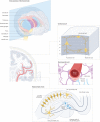Functional bioengineered models of the central nervous system
- PMID: 37064657
- PMCID: PMC9903289
- DOI: 10.1038/s44222-023-00027-7
Functional bioengineered models of the central nervous system
Abstract
The functional complexity of the central nervous system (CNS) is unparalleled in living organisms. Its nested cells, circuits and networks encode memories, move bodies and generate experiences. Neural tissues can be engineered to assemble model systems that recapitulate essential features of the CNS and to investigate neurodevelopment, delineate pathophysiology, improve regeneration and accelerate drug discovery. In this Review, we discuss essential structure-function relationships of the CNS and examine materials and design considerations, including composition, scale, complexity and maturation, of cell biology-based and engineering-based CNS models. We highlight region-specific CNS models that can emulate functions of the cerebral cortex, hippocampus, spinal cord, neural-X interfaces and other regions, and investigate a range of applications for CNS models, including fundamental and clinical research. We conclude with an outlook to future possibilities of CNS models, highlighting the engineering challenges that remain to be overcome.
Keywords: Biomimetics; Learning and memory.
© Springer Nature Limited 2023, Springer Nature or its licensor (e.g. a society or other partner) holds exclusive rights to this article under a publishing agreement with the author(s) or other rightsholder(s); author self-archiving of the accepted manuscript version of this article is solely governed by the terms of such publishing agreement and applicable law.
Conflict of interest statement
Competing interestsThe authors declare no conflicts of competing interest, financial or otherwise.
Figures




Similar articles
-
Reorganization of the human central nervous system.Gen Physiol Biophys. 2000 Oct;19 Suppl 1:11-240. Gen Physiol Biophys. 2000. PMID: 11252267 Review.
-
Bioactive injectable hydrogels for on demand molecule/cell delivery and for tissue regeneration in the central nervous system.Acta Biomater. 2022 Mar 1;140:88-101. doi: 10.1016/j.actbio.2021.11.038. Epub 2021 Nov 28. Acta Biomater. 2022. PMID: 34852302 Review.
-
Recent progress in translational engineered in vitro models of the central nervous system.Brain. 2020 Dec 5;143(11):3181-3213. doi: 10.1093/brain/awaa268. Brain. 2020. PMID: 33020798 Free PMC article. Review.
-
Three-dimensional Tissue Engineered Aligned Astrocyte Networks to Recapitulate Developmental Mechanisms and Facilitate Nervous System Regeneration.J Vis Exp. 2018 Jan 10;(131):55848. doi: 10.3791/55848. J Vis Exp. 2018. PMID: 29364269 Free PMC article.
-
New insights into anatomical connectivity along the anterior-posterior axis of the human hippocampus using in vivo quantitative fibre tracking.Elife. 2022 Nov 8;11:e76143. doi: 10.7554/eLife.76143. Elife. 2022. PMID: 36345716 Free PMC article.
Cited by
-
Vital Characteristics Cellular Neural Network (VCeNN) for Melanoma Lesion Segmentation: A Biologically Inspired Deep Learning Approach.J Imaging Inform Med. 2025 Apr;38(2):1147-1164. doi: 10.1007/s10278-024-01257-w. Epub 2024 Sep 16. J Imaging Inform Med. 2025. PMID: 39284982 Free PMC article.
-
Meta-analysis of the make-up and properties of in vitro models of the healthy and diseased blood-brain barrier.Nat Biomed Eng. 2025 Apr;9(4):566-598. doi: 10.1038/s41551-024-01250-2. Epub 2024 Sep 20. Nat Biomed Eng. 2025. PMID: 39304761
-
Prospects of induced pluripotent stem cells in treating advancing Alzheimer's disease: A review.Histol Histopathol. 2025 Feb;40(2):157-170. doi: 10.14670/HH-18-766. Epub 2024 May 21. Histol Histopathol. 2025. PMID: 38847077 Review.
-
From Molecules to Mind: The Critical Role of Chitosan, Collagen, Alginate, and Other Biopolymers in Neuroprotection and Neurodegeneration.Molecules. 2025 Feb 22;30(5):1017. doi: 10.3390/molecules30051017. Molecules. 2025. PMID: 40076240 Free PMC article. Review.
-
The Multiple Realizability of Sentience in Living Systems and Beyond.eNeuro. 2023 Nov 14;10(11):ENEURO.0375-23.2023. doi: 10.1523/ENEURO.0375-23.2023. Print 2023 Nov. eNeuro. 2023. PMID: 37963652 Free PMC article. No abstract available.
References
Publication types
Grants and funding
LinkOut - more resources
Full Text Sources
